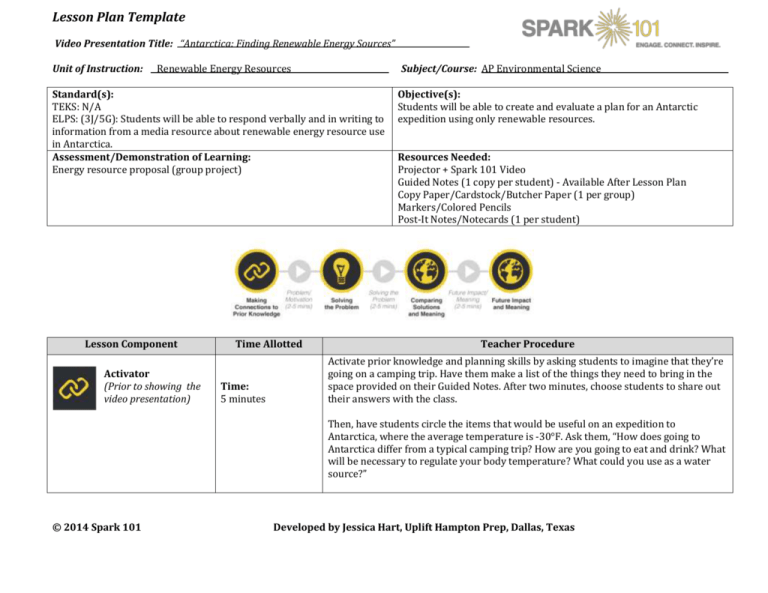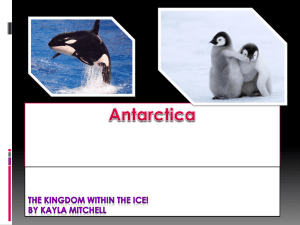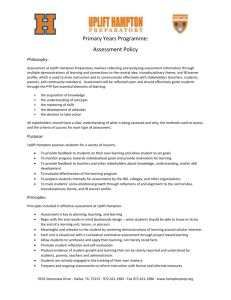Spark 101 Antarctica Renewable Energy HS Science Lesson Plan
advertisement

Lesson Plan Template Video Presentation Title: “Antarctica: Finding Renewable Energy Sources” Unit of Instruction: Renewable Energy Resources Subject/Course: AP Environmental Science Standard(s): TEKS: N/A ELPS: (3J/5G): Students will be able to respond verbally and in writing to information from a media resource about renewable energy resource use in Antarctica. Assessment/Demonstration of Learning: Energy resource proposal (group project) Lesson Component Activator (Prior to showing the video presentation) Time Allotted Time: 5 minutes Objective(s): Students will be able to create and evaluate a plan for an Antarctic expedition using only renewable resources. Resources Needed: Projector + Spark 101 Video Guided Notes (1 copy per student) - Available After Lesson Plan Copy Paper/Cardstock/Butcher Paper (1 per group) Markers/Colored Pencils Post-It Notes/Notecards (1 per student) Teacher Procedure Activate prior knowledge and planning skills by asking students to imagine that they’re going on a camping trip. Have them make a list of the things they need to bring in the space provided on their Guided Notes. After two minutes, choose students to share out their answers with the class. Then, have students circle the items that would be useful on an expedition to Antarctica, where the average temperature is -30°F. Ask them, “How does going to Antarctica differ from a typical camping trip? How are you going to eat and drink? What will be necessary to regulate your body temperature? What could you use as a water source?” © 2014 Spark 101 Developed by Jessica Hart, Uplift Hampton Prep, Dallas, Texas Problem/Motivation (Part I of video) Time: 2-5 minutes Show this first segment of the video to your students, letting them know that they will be working on solving the real-world problem after viewing. After the first segment of the video, have students read “Part I” on their Guided Notes. Problem Solving Activity (Describe process for identifying possible solution(s) to the problem presented) Time: 30 minutes Grouping: Independent Pairs Small groups (3-5) Whole group Allow students to work in small groups to complete the “4 Corners and a Diamond” section on their Guided Notes to illustrate their thinking as they discuss the problem. Walk around as students are working to ask probing questions, correct misconceptions, or extend students’ thinking as necessary. Challenge their decisions, and have them defend their answers. (See questions below.) Have students work in their groups to use the “4 Corners and a Diamond” graphic organizer they just completed and draft a final proposal on a separate piece of paper/cardstock/butcher paper. Depending on time and intended learning outcomes, have students share their solutions with the rest of the class in one of the following ways: Post the proposals around the room, and have students do a Gallery Walk to look at all of the other groups’ work. You can also give them Post-It notes to provide feedback to other groups and initiate discussion by posting questions, challenges, or compliments on other groups’ proposals. Have students present their proposals to the rest of the class by giving a presentation. You can have students role-play a proposal scenario in which they must persuade an investor/committee/etc. to invest in their plan. You can also provide a reward to the group with the best presentation. Checks for Understanding What are the three constraints we need to keep in mind while solving this problem? What do you already know about the climate of Antarctica? Which biome is this? Describe characteristics of this biome. What challenges can we expect to face while we’re there? Does it make more sense to melt snow for drinking water or bring along drinking water? Why? Why is it important to test technologies before the trip? Where should they be tested? Why? If we could use non-renewable resources, which ones would we use? © 2014 Spark 101 Developed by Jessica Hart, Uplift Hampton Prep, Dallas, Texas Solving the Problem (Part II of video) Comparing Solutions and Meaning (Describe process for identifying possible solution(s) to the problem presented) Future Impact and Meaning (Part III of video) Time: 2-5 minutes Time: 5 minutes Grouping: Independent Pairs Small groups (3-5) Whole group Time: 2-5 minutes Future Impact and Meaning (Have students reflect on how solving the problem might relate to current or future goals) Time: 5 minutes Summarizer/Closure Time: 5 minutes © 2014 Spark 101 Grouping: Independent Pairs Small groups (3-5) Whole group Show this second segment of the video to your students, letting them know that they will be comparing their solutions to the actual solution shared by the industry professional(s). After the second part of the video, have students work in their groups to discuss and write answers to the following questions on their Guided Notes: Which technologies did the team end up using? How did they work? Where did the team test the technologies? Why did they do this? Checks for Understanding Cold call on groups to share out their answers with the rest of the class. Show this third and final segment of the video to your students, letting them know that they will be reflecting on their thoughts related to pursing possible education pathways and careers presented in the video. After the third part of the Spark 101 video, have students work in their groups to discuss and write answers to the following questions on their Guided Notes: How were your solutions similar to those generated by the team? How were they different? In cases where they were different, which solution was better? Why? Checks for Understanding Cold call on groups to share out their answers with the rest of the class. Option 1: Wedding Tradition Exit Ticket Give each student a notecard, and have them separate it into four sections and label and respond as follows: Section 1 - Something Old: In this section, students will write a piece of prior knowledge that they knew before today that was useful for solving today’s problem. Section 2 – Something New: In this section, students will write something that they learned today that was useful for solving the problem. Section 3 – Something Borrowed: In this section, students will write something that another student said that was useful for solving today’s problem. Section 4 – Something Blue: In this section, students will write something “blue” – meaning, something that stood out as interesting or unusual while solving the problem today. Developed by Jessica Hart, Uplift Hampton Prep, Dallas, Texas Assessment (if applicable) Option 2: Post-It Board Closure: Have students complete one of the following sentence stems, write it on a Post-It, and stick it on the board/door as they leave the classroom: What grabbed my attention the most today was… Something that was new or surprising today was… One thing that I learned that I may be able to use in the future is… I am still unsure about… A question I still have about this is… Something we did today that relates to my college or career goals is… Have teams turn in their proposals at the end of the class period. Differentiation for Diverse Learners: Additional Notes (if needed) Accommodations/Modifications for Special Populations: Provide extra time to complete tasks. Provide a correctly completed example of the task. Provide visuals of renewable and non-renewable energy resources for use during discussion. Begin with a KWL or other instructional strategy to activate prior knowledge of energy resources. English Language Learners: Allow some native language discussion in small groups. Allow students to respond to checks for understanding and questions in writing rather than verbally. Provide visuals of renewable and non-renewable energy resources for use during discussion. Explicitly teach (or re-teach) challenging vocabulary words. CK12 Connections (if available) Extensions for Advanced Learners: Add more constraints for the problem solving scenario: specific budget amounts, equipment is not working, specific time limits, specific weight allowances, etc. Have students conduct outside research to solve the problem according to these new constraints. Have students pitch their proposal to the rest of the class, and have the class respond with constructive critiques and probing questions to challenge the group. OpenStax Connections (if available) Free videos, activities, problems, and background text available at: http://www.ck12.org/earth-science/Renewable-Energy-Resources/ © 2014 Spark 101 Developed by Jessica Hart, Uplift Hampton Prep, Dallas, Texas Name: _____________________________________________________ Date: _____________________ Guided Notes: Antarctica – Finding Renewable Energy Sources Imagine you’re going on a camping trip. Make a list of the items you need to bring. _________________ _________________ _________________ _________________ _________________ _________________ _________________ _________________ _________________ _________________ _________________ _________________ _________________ _________________ _________________ Look at the items you listed above. Circle the ones that would be useful to you on an Antarctic Expedition, where the average temperature is -30°F. How are you going to eat and drink? What could you use as a water source? Antarctic Expedition Challenge: Part I This video highlights Lockheed Martin’s effort to help Robert Swan, noted polar explorer, assess renewable energy for a 50-day, 900-mile journey from the South Pole to the coast of Antarctica. Consider the team’s requirements below: Enough energy for 8 people to melt snow for drinking water, heat food, charge radios and cameras, and stay warm for at least 50 days. Energy sources need to be renewable. Technologies that are light and compact enough to fit on a sled. Inexpensive materials (less than $30,000) © 2014 Spark 101 Developed by Jessica Hart, Uplift Hampton Prep, Dallas, Texas Using the graphic organizer you just completed, work with your group to draft a final proposal on a separate piece of paper that details your Antarctic expedition plan. Antarctic Expedition Challenge: Part II Which technologies did the team end up using? How did they work? Where did the team test the technologies? Why did they do this? Antarctic Expedition Challenge: Part III How were your solutions similar to those generated by the team? How were they different? In cases where they were different, which solution was better? Why? © 2014 Spark 101 Developed by Jessica Hart, Uplift Hampton Prep, Dallas, Texas








